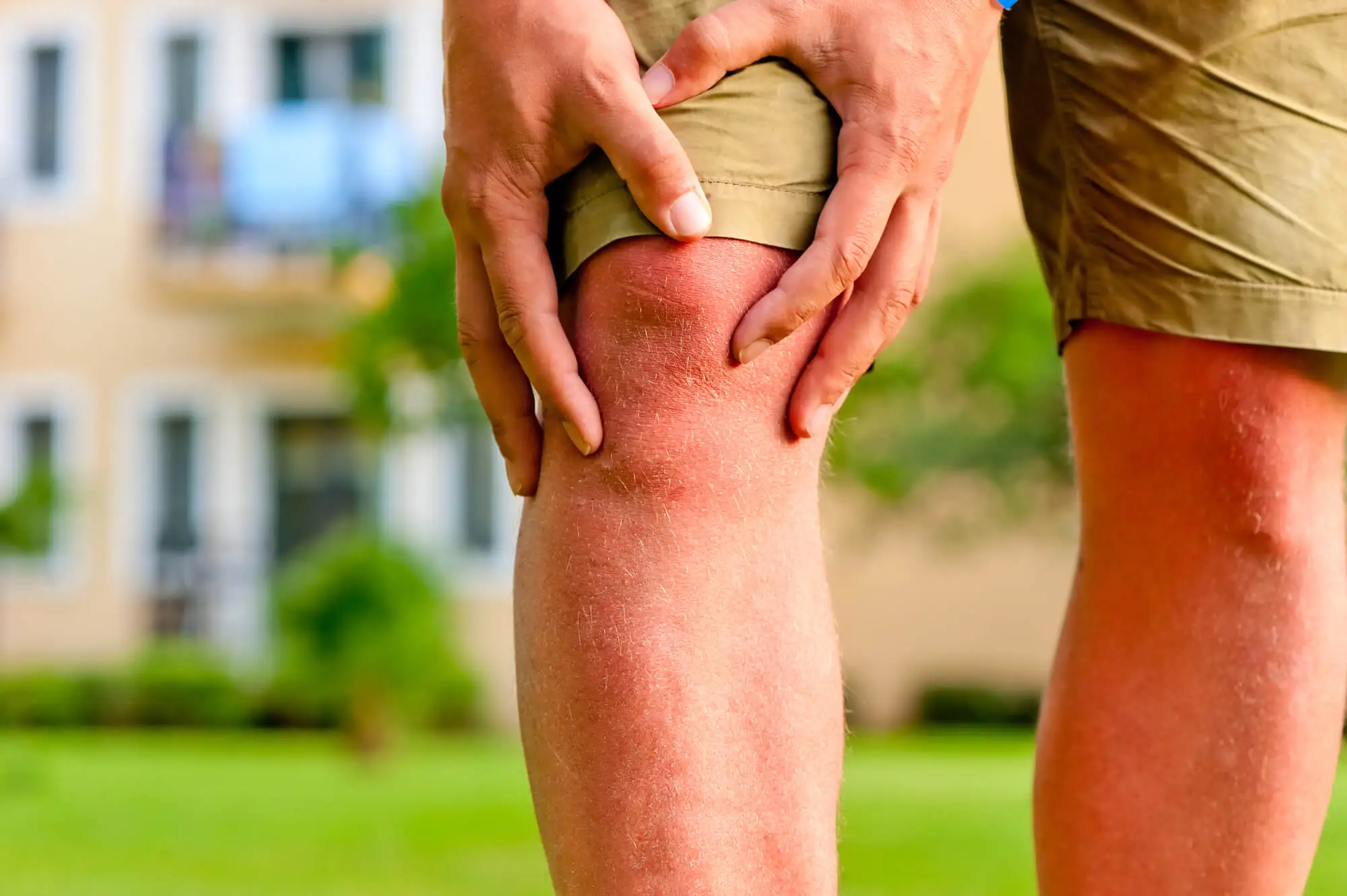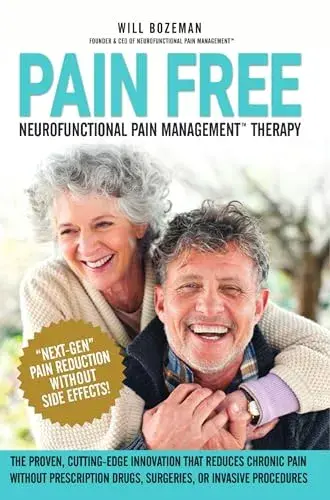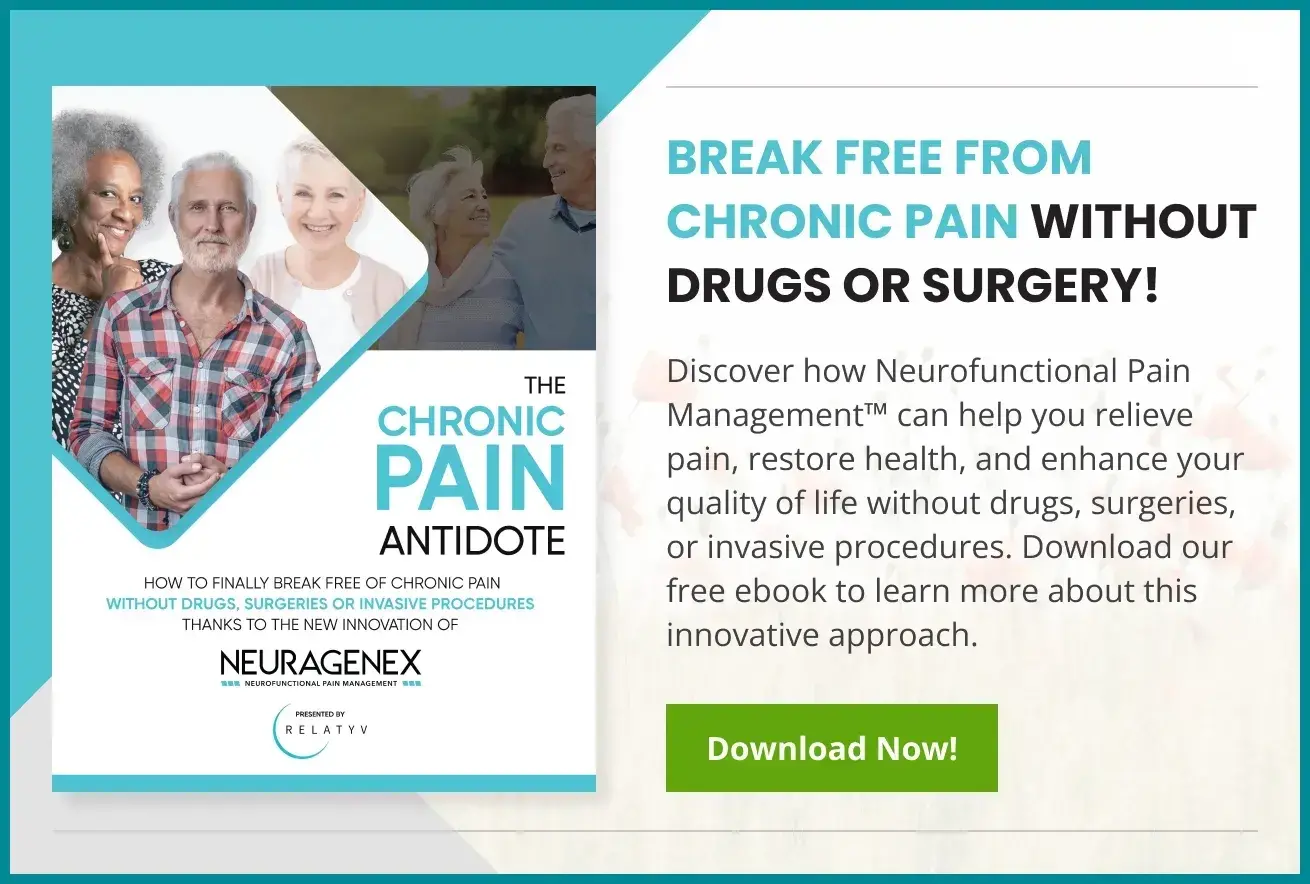Osteoarthritis

Osteoporosis Vs. Arthritis: What To Know About These Conditions
Read More
November 21, 2022
Nearly 33 million adults in the United States alone live with the effects of osteoarthritis.
Much like other conditions of pain which affect the extremities of the body, osteoarthritis is a condition that often manifests in the knee, fingers, and toes of patients who have been diagnosed with it.
The causes of osteoarthritis are fairly distinct and must be treated as an entirely separate type of chronic pain condition because osteoarthritis is a wear-and-tear condition that happens over time with joints.
Unlike other conditions that have a specific starting element or trigger event like an infection, osteoarthritis develops over time and there’s no effective solution to prevent this from happening.
However, there are effective solutions for treating the symptoms associated with this condition.
Relatyv has pioneered the field of Neurofunctional Pain Management to do just that—bring an effective treatment solution to patients suffering from chronic osteoarthritis pain and who are looking for options before going down the path of surgery.
The question which must first be answered by patients is whether osteoarthritis is a legitimately treatable condition, or will it simply be a situation for management of symptoms where the patient is going to be seeking a pain relief solution for life. Can a chronic condition so elusive and misunderstood have an effective treatment?
The fact is, just about any pain condition is treatable, to some degree, with a range of therapies. Whether a treatment is safe, effective, or affordable relies on the subjectivity of the patients and their physicians.
However, for osteoarthritis, treatment efficacy and safety vary depending on the patient’s willingness to explore and procure said treatments.
For many, invasive surgeries like knee replacement is out of the question, and most will turn to nonsurgical options for treatment before turning to surgery. The reality is that there are many treatments and therapies that can last a long time and successfully manage the chronic symptoms of osteoarthritis.
At the very least, it is a solid strategy to put off surgery and knee replacement as long as possible.
When we speak of nonsurgical options for treatment, we must consider that these treatments are not always effective (nor recommended) for many patients who suffer from the pain of any condition.
However, for osteoarthritis, seeing how it has affected, and continues to affect, millions of adults in the United States alone, there has been comprehensive research done in search of a treatment or a cure that does not involve extensive and invasive surgery.
Unlike many other conditions of pain, cases and prevalence of osteoarthritis have remained steadily increasing among American adults and is still one of the top health concerns among patients and providers.
The growing number of cases has contributed to a steady and persistent level of research into a treatment for the condition and this should be a welcome relief for anyone seeking said treatment.
Unfortunately, research within the medical community concludes that effective treatment for osteoarthritis is elusive and often lacks the efficacy desired by both patients and their doctors.
There are newer regenerative options in recent years that are starting to gain repute among physicians, but for this article, we will stick to the concept of Neurofunctional Pain Management as a treatment model for osteoarthritis.
To this day, osteoarthritis remains a clinically challenging condition to diagnose and treat. Because of this, it is important for healthcare professionals and patients to assess the impact that a certain treatment will have on the life and health of individuals before prescribing it.
And, to do so, it is crucial to make a distinction between the efficacy and the effectiveness of treatment:
In the case of osteoarthritis, healthcare professionals might recommend a therapy that aims to ease the symptoms a patient is experiencing, mostly basing their decision-making on research findings and studies. However, to understand whether that treatment will be effective for each individual, it is also important to account for lifestyle factors and the level of commitment the patient has toward the treatment.
For example, NSAIDs and opioid-based treatments might be efficient in reducing a patient’s symptoms, but they are not effective in boosting a patient’s life quality and treating the pain’s underlying condition.
Additionally, determining the effectiveness of a treatment for osteoarthritis before recommending it is essential to safeguard patients from unnecessary exposure to risks, complications, and side effects, such as dependence, digestive issues, fatigue, and dizziness.
Working with a patient to understand what treatment will work best for their lifestyle and goals is the first step to increasing their chances of keeping at bay degenerative joint diseases.
With the need for effective nonsurgical treatment of osteoarthritis being sought by patients, even professionals in the medical community like Professor Brandt are frustrated at the lack of effective options available to their patients.
Professor Brandt– after surveying the available options, their limited benefits, and many side-effects, states that “. . . we surely need better and safer drugs to treat OA [osteoarthritis] symptoms” (2004).
The last thing osteoarthritis patients want to hear is that the symptoms they are attempting to treat with better and safer drugs are met with sometimes worsening side effects.
Throughout the survey of treatments, Professor Brandt also concludes that some drugs had little to no effect in a clinical trial when compared to the effects of a placebo.
It is perhaps most disconcerting to hear this statement which sums up the entirety of Professor Brandt’s concern:
“Despite enormous increases in our understanding of pain mechanisms and of the metabolism, biochemistry, and molecular biology of articular cartilage . . . our track record for the development of more efficacious drug treatment for OA [osteoarthritis] is discouraging”.
This is not to say that treatments do not exist for osteoarthritis; in fact, there are several. The issue that Professor Brandt brings succinctly to the forefront is the issue of efficacy.
One of the most common and nonsurgical treatments for osteoarthritis is the use of nutraceuticals. Nutraceuticals are dietary supplements that claim to improve the life expectancy and health care of an individual when used in tandem with healthy foods.
The general assumption of nutraceutical efficacy works in tandem with the patient’s willingness to live a healthy lifestyle. The specific nutraceuticals that treat osteoarthritis include glucosamine and chondroitin methylsulfonylmethane.
The efficacy of these treatments has been debated among peers in the medical community for decades. Notwithstanding, Dr. Begum Yurdakok Dikmen, a Turkish physician counters that nutraceuticals have been introduced as a form of treatment over the centuries and that many suffering from osteoarthritis look to them for a solution.
In a study on nutraceuticals done in 2016, Dr. Dikmen grappled with the fact that “[r]egulations regarding the quality and safety of nutraceuticals are still being debated . . .” (2016). This is in part due to the medical community’s skepticism of nutraceuticals being seen as an alternative medicinal treatment for osteoarthritis.
However, Dikmen states that nutraceuticals are still being considered by governmental bodies that will continue to “. . . develop strategies together with the public to enlighten the benefits supported by solid scientific evidence”.
Understandably, skepticism continues to be a persistent hindrance for the use of nutraceuticals in the treatment of osteoarthritis. This skepticism lies not only in physicians with patients who suffer from osteoarthritis but in the patients themselves.
Many would rather consider a lasting treatment that they know will work for them before ingesting a nutraceutical with which they are unfamiliar.
A study conducted by Marco Antônio Percope de Andrade M.DPh.D. concluded that glucosamine hydrochloride, a nutraceutical, “ . . . had no effect on pain management” (2015) when it came to treating osteoarthritis.
Dr. de Andrade confirmed that results from more familiar sources for nutraceuticals such as avocado and soybeans were less conclusive and “. . . may have positive effects on the knee and hip OA [osteoarthritis], but long-term results could not be confirmed”.
These conclusions on the benefits of nutraceuticals are both disappointing and frustrating, especially for those who are seeking relief from pain. While some patients who suffer from osteoarthritis may feel a small amount of relief from the pain when using nutraceuticals, lasting relief will not be found.
In the year 2000, a clinical trial evaluating the efficacy of another nonsurgical treatment known as hyaluronic acid (HA) viscosupplementation was conducted.
While the clinical trials of viscosupplementation were in their infancy, Dr. John Watterson found that “. . . the lack of systemic side effects and the potentially lasting effects make it an appealing option” (2000). The process of viscosupplementation is best described as a loosening and relaxing of the joints that feel stiff and rusted over.
This nonsurgical option uses a safe compound called hyaluronic acid. Hyaluronic acid has been USDA approved for decades and Dr. Watterson attests to this benefit by stating that “[t]he US Food and Drug Administration approval of hyaluronic acid as a device has avoided the need for meeting the more stringent criteria for approval as a drug”.
Decades later, the use of hyaluronic acid in viscosupplementation has remained an effective and affordable solution to treat osteoarthritis.
Beyond viscosupplementation, there are perhaps more nonsurgical options that will help, options that are made available through Relatyv and the use of Neurofunctional Pain Management.
Neurofunctional Pain Management refers to a patented, proprietary treatment protocol that is non-surgical, non-invasive, and opioid-free. This treatment program is entirely customized to meet the needs, goals, and medical history of a certain patient, and leverages the body’s own self-healing mechanisms.
At Relatyv, Neurofunctional Pain Management is delivered as a combination of high-pulse electrical stimulation, hydrotherapy, and massage therapies (Neurassage). These treatments, which promote tissue regeneration and pain relief, are coupled with lifestyle counseling and IV therapies to boost the overall quality of a patient’s life.
In the case of OA patients, Neurofunctional Pain Management programs aim to reduce joint pain while also supporting the regeneration of damaged cartilage and bone tissue, strengthening the muscles, and improving a patient’s range of motion.
In the sections below, you can learn more about the benefits that Neurofunctional Pain Management offers and how these are achieved through therapies such as viscosupplementation, electroanalgesia, IV therapy, hydrotherapy, massages, and lifestyle counseling.
Relatyv uses the most advanced electroanalgesic treatments to deliver long-lasting pain relief to people with OA. Electroanalgesia – which refers to a treatment that uses electrical impulses to ease the pain – is administered through FDA-cleared equipment and performed by highly skilled MDs.
Unlike weaker at-home TENS units, Nuragenex’s electroanalgesic treatments use high-pulse electrical stimulation. The high-frequency, high-accuracy electrical impulses provide longer-lasting results by modulating how pain signals travel to the brain and boosting the production of feel-good agents such as endorphins in the body.
What’s more, high-frequency electrical stimulation can support improved blood circulation in the area affected or damaged by OA, thus reducing swelling and improving the supply of oxygen and essential nutrients, which contribute to tissue healing and regeneration.
Viscosupplementation alone won’t yield the expected results without the necessary lifestyle changes. At Relatyv, our team’s goal is to address all factors that might be worsening OA, contributing to pain, or affecting the overall health of our patients.
In particular, we value the role that nutrition plays in the prevalence and morbidity of conditions such as OA. For example, being overweight or obese is the single greatest modifiable risk factor for OA. Additionally, recent studies have shown the role that deficiencies of certain minerals and vitamins – namely magnesium, Vitamin D, and Vitamin K – can play in increasing the risk of developing OA.
Lastly, proper nutrition is linked to overall well-being, and, especially in people with musculoskeletal diseases and degenerative joint disorders, it can support the health and strength of muscles, blood vessels, and bones. In turn, the systems and tissues that surround the joint, when healthy, can counteract the effect of OA and delay the need for surgery.
To prevent and suppress nutritional deficiencies, at Relatyv, we deliver custom IV therapies that have anti-inflammatory, immune-boosting, and hydrating effects. In our neurofunctional Pain Management protocols we also leverage hydrotherapy to provide high levels of hydration.
Since obtaining approval in 1997, Hyaluronic Acid (HA) has taken the world by storm. Today, it can be found in a myriad of medical and consumer products, and research findings on its beneficial effects could not be more promising.
So, why is HA viscosupplementation one of the main pillars of Neurofunctional Pain Management programs at Relatyv?
As seen above, one of the most appealing qualities of HA at the time of the first clinical trials was that it didn’t seem to have side effects. However, thanks to the research available today, we know that not only HA is safe, but it also carries great regenerative potential.
For Neurofunctional Pain Management therapies designed for people with arthritis, HA viscosupplementation can help replenish the declining synovial fluid, support the regeneration of cartilaginous tissue, and reduce pain in the long term.
When freed from the pain deriving from OA, patients can begin to establish a healthier, more active lifestyle. And this lifestyle, in turn, can help them regain control of their life and boost their overall health.
As a positive consequence of these changes, patients can rely on a stronger musculoskeletal and circulatory system, which can offset the degenerative potential of OA and ease its symptoms without resorting to NSAIDs, opioids, or surgery.
Relatyv incorporates the use of hyaluronic acid viscosupplementation in its Neurofunctional Pain Management program to treat knee pain. This treatment for osteoarthritis is an excellent therapy model for patients suffering from osteoarthritis.
This treatment also operates in conjunction with the pain-relieving and health restoration efforts of Neurofunctional Pain Management protocols that use high pulse electrical stimulation, electroanalgesia, and specialized hydration therapies that address nutritional vitamin and mineral deficiencies.
When it comes down to treating the pain deriving from osteoarthritis, it is crucial to maintain a holistic approach. This is because joint pain and the degeneration of cartilage can affect all areas of the body and all aspects of life. From reducing the range of motion to affecting productivity, causing disability, and even triggering emotional and mental disorders, the symptoms and consequences of OA are truly varied.
In turn, simply using intra-articular injections of hyaluronic acid, or relying on electrical stimulation alone might not be enough to help patients magnify their quality of life. However, an ad hoc combination of these therapies can – and that’s where the Relatyv approach comes in.
Relatyv has developed a proprietary treatment protocol called Neuralgesia, which incorporates the high-pulse electrical stimulation and specialized hydration therapies mentioned above, while also utilizing hyaluronic acid viscosupplementation for osteoarthritic knees.
While viscosupplementation relieves and loosens the joints affected by osteoarthritis, Neurofunctional Pain Management treatments further reduce the pain and attempts to restore the primary and underlying health condition of the patient so the pain relief effect can last as long as possible.
Many patients experiencing the symptoms of osteoarthritis report pain relief after only one session with Relatyv. Patients often experience greater mobility, strength, and requisition of the motor skills they used to enjoy completing their daily tasks.
Hundreds of patients experience relief from pain that is almost instant, and treatment is simple. Patients who suffer from chronic pain from osteoarthritis report relief after starting our Neuralgesia treatment sessions.
If you are affected by OA, the chances are that you are experiencing a negative effect on all areas of your private and professional life. However, simply easing the pain deriving from your inflammatory condition might not be enough to return to living your life to the fullest.
At Relatyv, our goal is just that – to help you magnify your life without invasive treatments, surgery, pharmaceuticals, and opioids. Thanks to our evidence-based, holistic Neurofunctional Pain Management protocol, we can help each of our patients go back to living in a body that is pain-free, mobile, and energetic.
This is why the mission statement of Relatyv is to magnify quality of life. It’s not just getting out of pain; it’s achieving a better quality of life, a magnified quality of life.
About the Author
Will is a healthcare executive, innovator, entrepreneur, inventor, and writer with a wide range of experience in the medical field. Will has multiple degrees in a wide range of subjects that give depth to his capability as an entrepreneur and capacity to operate as an innovative healthcare executive.
Share on Social Media




You can see how this popup was set up in our step-by-step guide: https://wppopupmaker.com/guides/auto-opening-announcement-popups/
You can see how this popup was set up in our step-by-step guide: https://wppopupmaker.com/guides/auto-opening-announcement-popups/
Neurofunctional Pain Management Overview
IV Therapy
Symptoms
Conditions Treated
Treatments
Articles by Category
Locations
Colorado
Wisconsin
Georgia
Hiram
Lawrenceville
Marietta
Powder Springs
Texas
Waco
Victoria
Illinois
Buffalo Grove
New Lenox
St. Charles
Arizona
Tucson
Waddell
Arlington
Avondale
Buckeye
Superior
Mesa
Palo Verde
Morristown
Tempe
Chandler
Anthem
Eloy
Florence
Fort McDowell
Phoenix
El Mirage
Coolidge
Gilbert
Arizona City
Casa Grande
Casa Blanca
Aguila
Sacaton
Apache Junction
Kearny
Stanfield
Goodyear
Litchfield Park
Alabama
Arkansas
California
Florida
Idaho
Michigan
Rhode Island
Minnesota
New Mexico
North Carolina
Ohio
Pennsylvania
South Dakota
Tennessee
Virginia

